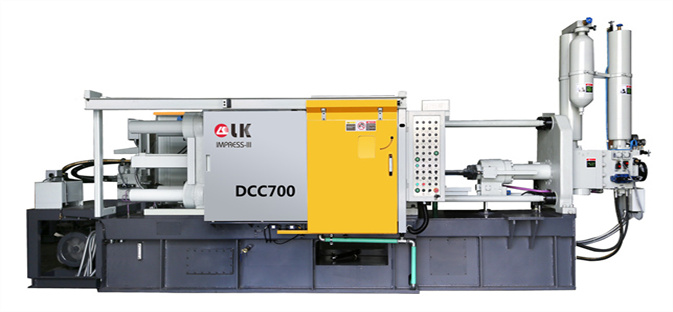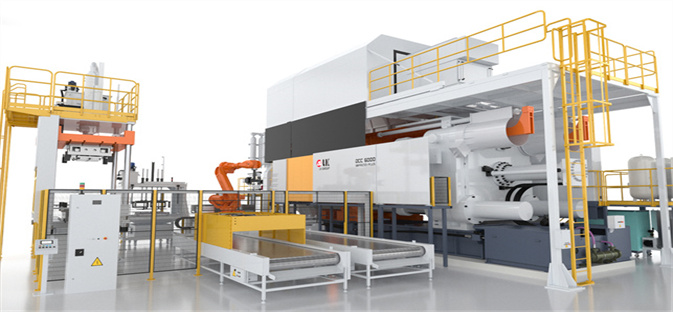What are the two types of die casting machines?
LK Die Casting Machine / 2024-06-12 15:56:52
In modern industrial production, die-casting machines are key manufacturing equipment used to inject molten metal into a mold to form the desired product. According to their working principles and structural characteristics, die-casting machines can be divided into two main types. This article will introduce the characteristics, application fields, advantages, and disadvantages of these two types.

1. Cold Chamber Die Casting Machine
Cold chamber die-casting machine is a common type of die-casting machine. Its main feature is that during the casting process, the molten metal and the mold are kept at a certain distance and do not directly contact each other. Its working principle is as follows:
Working principle: In a cold chamber die casting machine, metal materials are loaded into a container called a "cold chamber" and then pushed into the mold by the piston of the die casting machine. Before being injected into the mold, the molten metal enters the cold chamber through a nozzle and is injected into the mold after cooling to form the desired product.
Application field: A cold chamber die casting machine is suitable for processing high melting point metals such as aluminum alloys, magnesium alloys, etc. Because a certain distance is maintained between the metal and the mold, the cold chamber die-casting machine can handle high-temperature metals without damage.
Advantages and Disadvantages: The advantages of cold chamber die casting machines include fast production speed, high finished product precision, and suitability for high melting point metals; the disadvantages include high equipment cost, high energy consumption, and high maintenance cost.
2. Hot Chamber Die Casting Machine
Hot chamber die-casting machine is another common type of die-casting machine. Its main feature is that the molten metal is in direct contact with the mold during the casting process. Its working principle is as follows:
Working principle: In a hot chamber die casting machine, metal materials are loaded into a container called a "hot chamber" and kept at a certain temperature. When it needs to be injected into the mold, the piston pushes the molten metal into the mold and quickly solidifies it under high pressure.
Application areas: Hot chamber die casting machines are suitable for processing low melting point metals such as zinc alloys and lead alloys. Since the metal is in direct contact with the mold, hot chamber die-casting machines are more efficient in processing low melting point metals.
Advantages and Disadvantages: The advantages of hot chamber die casting machines include fast production speed, low energy consumption, and simple operation; the disadvantages include that they can only process low melting point metals and the product precision is slightly inferior.

Summary
Cold chamber die-casting machines and hot chamber die-casting machines are two common types of die-casting machines. They are suitable for processing different types of metal materials and have their own unique advantages and disadvantages. When choosing a die-casting machine, it is necessary to make comprehensive considerations based on specific production needs and material characteristics to ensure maximum production efficiency and product quality. I hope this article can help you better understand the different types of die-casting machines and their applications.
Contact LK Egypt ZAZ to learn more info about the die-casting machine.
Phone: +86 13598704163
Email: jack@zazmae.com https://www.zazdiecasting.com/
#die cast tooling
#trivalent chromate
#rapid prototype casting
#a360 aluminum
#aluminum caster
#aluminum prototype
#ideal 55 slider parts
#density of aluminum kg/mm3
#magnesium sheet metal
#parts of a metal gate
#subcontracting of screw machining for the luxury sector
#wall aluminum
#die casting tooling
#tooling for die casting
#density of aluminium in kg mm3
#clear chromate
#es casting metals
#gating material
#prototype aluminum
#sigma castings
#subcontracting of screw-machining for household appliances
#we squeeze to please machine
#aluminium gravity die casting
#aluminum part
#aluminum rapid prototyping
#nickel casting
#plunger tip for die casting machine
#rapid prototyping aluminium
OTHER CONTENT
-

2024-09-19 14:16:15 LK Cold Chamber Die Casting Machine DCC900 Locking Force: 9000KN Die Height: 400-1000mm Space Between Tie Bars: 930x930mm Shot Weight: 13.5Kg Casting Area Max:2250c㎡
More -

2024-09-19 14:11:06 LK Cold Chamber Die Casting Machine DCC280 Locking Force: 2800KN Die Height: 250-650mm Space Between Tie Bars: 560x560mm Shot Weight: 2.9Kg Casting Area Max:700c㎡
More -

2024-09-19 10:23:07 LK Cold Chamber Die Casting Machine DCC580 Locking Force: 5000KN Die Heigh: 350-850mm Space Between Tie Bars: 760x760mm Shot Weight: 6.9Kg Casting Area Max:1250c㎡
More -

2024-09-19 10:11:20 LK Cold Chamber Die Casting Machine DCC400 Locking Force: 4000KN Die Height: 300-700mm Space Between Tie Bars: 669x669mm Shot Weight: 4.7Kg Casting Area Max:1000c㎡
More

